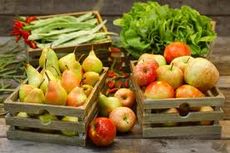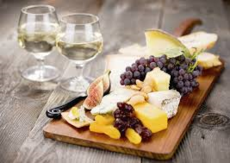Alcoholism
With Wine, You Drink What You Eat
Enhancing your palate while enjoying the fruits and vegetables of summer
Posted May 28, 2014

Food does more than complement wine. It shows us the flavors of wine. Fruits and vegetables, nuts and berries, herbs and spices can teach us about the flavors that naturally appear in our wines. In fact, developing a wine palate through eating can be accomplished in a few easy steps.
1) Begin with the basic categories of taste experience in wine: tannin, oak, acidity, sugar, alcohol, and fruit.
Tannin comes primarily from the skins of grapes and provides the structure for red wines. It can be astringent and potentially bitter. It is also abundant in tea, so to experience a direct dose of tannin, brew very rich black tea – steeping it a little too long – and drink it slowly, letting it coat the inside of your mouth. Oak comes from the barrels that the wine ages in and often shows itself as a hint – or a dollop – of vanilla. Acidity, which provides the structure for white wines, tastes tart and tangy. Bite into a lemon or a grapefruit and experience the acidic structure of white wines. Sugar, of course, tastes sweet. Alcohol is always in the wine glass but is often balanced with the fruit. If there’s too much alcohol and it’s out of balance with the fruit, it can leave a burning sensation on the finish, like the aftereffects of tequila. Which leaves the flavor profiles of the fruit – often the most complex experience in tasting wine, including fruit flavors but other flavors as well.
2) Learn the basic flavor profiles of popular varieties of wine
Red wines show flavors of red, purple, and black fruits and berries (cherry, strawberry, raspberry, blackberry, rhubarb, and plum – sometimes prune), along with black pepper, leather, tobacco, chocolate, vanilla, green bell pepper, and a mushroom earthiness. Herbally, red wines follow the lyrics of Simon and Garfunkle: parsley, sage, rosemary, and thyme – especially thyme. Specifically, for red wines, the following aromas and tastes show themselves in the glass.
• Cabernet Sauvignon: blackberry, pepper, chocolate, tobacco, vanilla (if oaked)
• Malbec: plums, red cherry, earth
• Zinfandel: black cherry, pepper, mint
• Syrah: blackberry, tobacco, black pepper, vanilla (if oaked), sometimes mint
• Pinot Noir: raspberry, rhubarb, red cherry, mushroom earthiness
• Grenache: strawberry, raspberry, smoke, black pepper

White wines exhibit flavors of light, tart fruits, with a focus on citrus and tropical fruits (pineapple, kiwi, lemon, lime, grapefruit) and fruits with lighter flesh (apple, pear, and apricot), along with fig, honey, butter, almond, asparagus, and natural grasses. Vanilla can appear in white wines if the wine has been aged in mostly new oak barrels, as is sometimes the case with California Chardonnays. Chardonnays that smell of butter or caramel have been aged in oak and proceeded through a secondary, malolactic fermentation, which converts malic acid to lactic acid, the acid in milk.
• Riesling: citrus, peach, honey
• Chardonnay: pear, apple, butter (if oaked), vanilla,
• Sauvignon Blanc: grapefruit, lime, asparagus,
• Pinot Gris: peach, pear, apricot
• Viognier: apple, pear, mineral, floral
• Champagne: apple, pear, strawberry, yeast, nuttiness
• Prosecco: apple, honey, citrus
3) Learn the tastes of wine by eating the foods whose aromas and flavors appear in wine. Go to the grocery and buy your favorite fruits, berries, herbs, and vegetables. Eat strawberries, raspberries, and rhubarb and remember those flavors when tasting a few different Pinot Noirs – to see if you can detect these fruits. Eat butter (yes butter!), pears, and ripe green apples, and then taste for those flavors when drinking a flight of Chardonnays. Eat blackberries, red cherries, and chocolate, and then have a Napa Valley Cabernet Sauvignon. Find the flavors of your food in the flavors of your wine.
Importantly, flavors do not sing solos. They sing with other flavors, often in harmony.

A more advanced approach to eating the flavors of wine is to eat foods in appropriate, unfamiliar combinations. Grind black pepper over sliced dark cherries and mint and remember that combination when you drink a Zinfandel. Eat raspberries and mushrooms and then remember that two-part harmony when you drink a Pinot Noir.
If you are feeling adventurous, move beyond fruits and vegetables. Briefly chew on a cigar, deeply smell a pile of leaves, visit a barn and take in the different aromas of animals, hay, and leather.
4) Taste the pairing of wines. Choosing what wine to pair with your food may be the most challenging part of learning about wine, so let the food choose for you. Rather than learn specific pairings, be familiar with the main ingredients in your dishes and the flavor profiles of wines. Think of the fruit and vegetable flavors in your wine and ask yourself what goes well with those fruits and vegetables. Plums and cherries do not go well with cod, so don’t choose plums and cherries in the form of Malbec for cod. Citrus does go well with cod, so choose a citrusy, grapefruity wine to go with the cod – maybe Sauvignon Blanc. On the other hand, deep, rich fruits go well with lamb, so choose the deep, rich fruits of a Cabernet Sauvignon or red Bordeaux to go with your lamb. Duck goes well with tart cherries, so choose the tart cherry flavors of Pinot Noir for duck.

Even if the pairings do not work perfectly, you will have the joy of eating fresh fruits and drinking delicious wine. A garden of earthly tastes waits to be detected, remembered, and appreciated.


